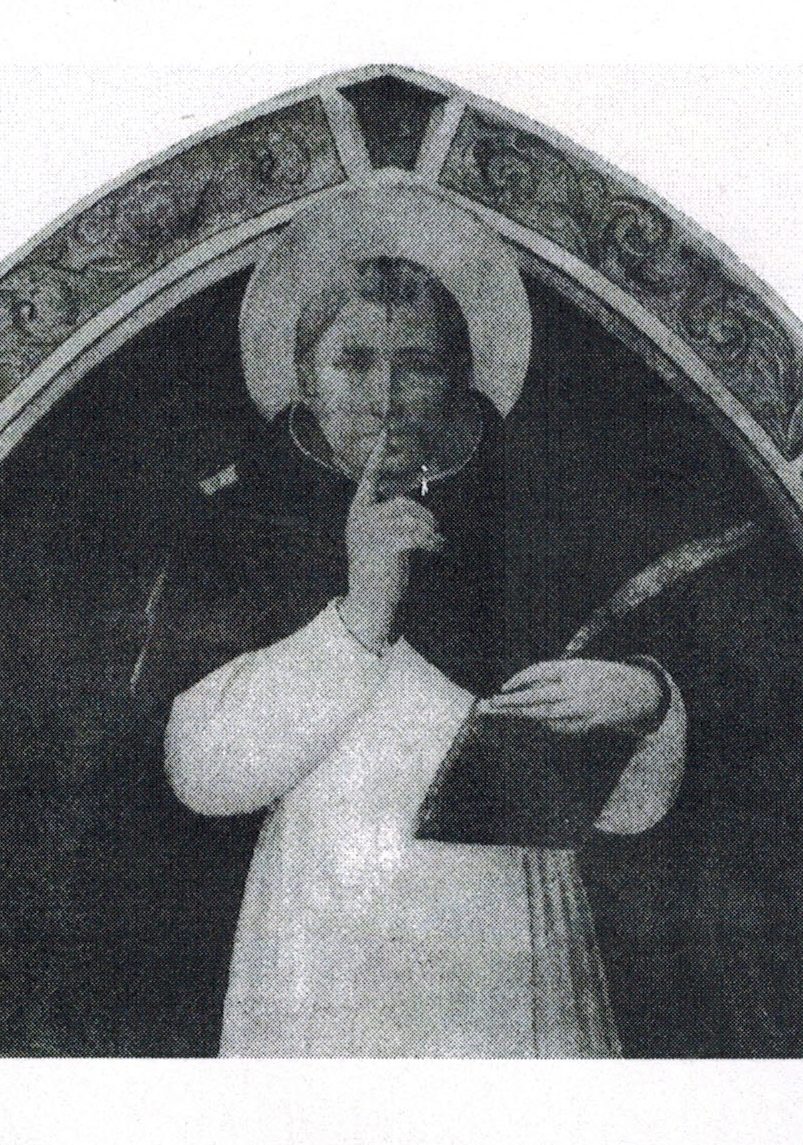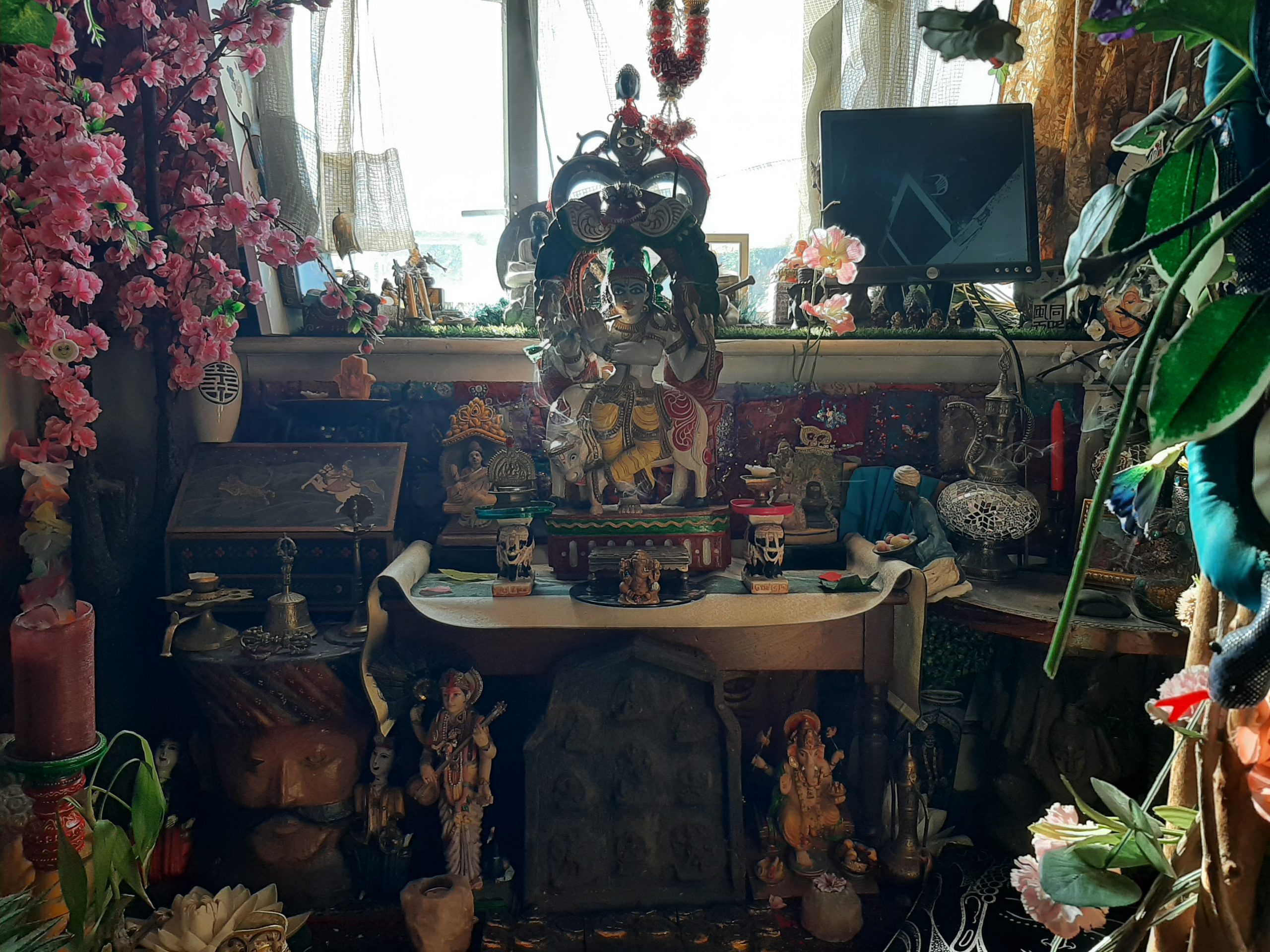Sanctuary

Come on in…
One idea in Western-style Meditation is to become more grounded in oneself as opposed to trying to transport oneself out of one’s skin up to a Great Beyond. The Institute’s main sanctuary is Eastern in style but it is for each individual to come up with personal ideas of a place conducive to allowing his or her personality to emerge.
Exalted notions may be de trop for a session of reflection. People who are sensitive to surroundings can choose the backdrop for reflection with care. Its foredrop – to coin a neologism – may work best on the principle that the loftiest thoughts can come to one when in, say, a cathedral. A video of a domestic sanctuary as below is an option for the visitor wishing to cogitate on ideas discussed in the Institute or his own thoughts.
A domestic shrine might be minimalist table ornamentation
The idea is to get one’s brain in order for reflection howsoever one chooses to do it.

The subconscious voice often is founded on initial impressions in life, then conscious layers later overlay them. We look up to parents and teachers and, also, the child is father to the man. We look up to our earliest totems. Someone who wishes to attune himself to his inner voice may like to surround himself with scenes or artefacts that call to his mind the early phases of his life, a time when one is more in touch with one’s original thinking. Marcel Proust in ‘In Search of Lost Time’ described how, as a child, his aunt gave him madeleines dipped in tea. To the adult Proust the act of eating a madeleine resurrected the context of his childhood. The memories come to him as a sensual activity without being summoned, not an intellectual one. A conscious act and reminders of congenial former surroundings can help to restore the thread of memory.

An adult may sit in front of a display like that above and find himself carried back to a time when he first saw similar imagery. It may remind him of an experience that had an emotional, seminal impact. A young boy may have dreamed of a life on the ocean wave, or sailing his model yaught, and spent happy minutes or hours in reveries about it. The refreshing of his association with a past-time enjoyed in his youth may, on the recollection, induce feelings of peace. Even elation. The sailor in the picture at the top of this section conjecturally never heard of Buddha but he is capable of sitting and contemplating; reflecting.
Rabbi Lionel Blue wrote of his Sanctuary: ‘Mine is an ordinary semi in a suburb, but it is not a machine à habiter It is a sanctuary where friends become family, where sentimental rubbish is treated with reverence and where more prayers are said than in a synagogue.’
In whatever is your sanctuary, atmosphere and at times atmospherics are ways of adjusting mood.
A joss stick or incense – much as can be used in a church as much as an Ashram – may be helpful. A soothing aroma such as SANCTUARY Sleep Mist may be to the taste of some visitors.
Below is a scene from the main Shrine of the Institute:
A mild distraction is often helpful for meditation particularly for those of an active disposition.
Given that our subconscious is acting on us all the time and our reflexes are hundreds of times faster than our cerebral minds make them, aural stimuli can have a pronounced effect.
The waterfall in the video clip above may serve a dual function: the water aspect, and the Eastern depiction of Buddha. The sound of flowing water is usually soothing. Our bodies are some 75% water and sound waves travel more quickly through water than air.
Gentle music may heighten a Sanctuary experience. Some people may like a cosy feeling as engendered by a crackling fire or being indoors while it is raining.
Theravadin monks/nuns occasionally hear music but, if they are observing their precepts, they do not actively listen to it, revel or delight in it. It is a training precept in the monastic discipline. On this principle, Musak, even, may come into its own. Those with a musical ear otherwise may be drawn too far into a focus on the particular piece being played. There are countless suitable musical buffets available at the click of a mouse, from Raga by say Ravi Shankar to Tibetan Sound Baths and….well, click away….
‘MEDITATION’ by Jules Massenet.
Or another sample of Shaman Music.
Here is another piece of music conducive to reflection
La Luna
Another suggestion is the Hawaiian practice of Ho Oponopono. Certain classical compositions by contrast may be less than conducive to cogitation. Woody Allen once said: ‘Every time I hear Wagner, I want to attack Poland!‘ It is advisable to eschew dramatic music like for instance ‘WOLF TOTEM’ by ‘the Hu’, a Mongolian Heavy Metal group reminiscent of a horde of Ghenghis Khan lookalikes!
Do police sirens disturb meditation? In meditation, sounds may be perceived as unpleasant but not taken ‘personally’. The Hari Krishna movement is one out of many examples of practices in which the sound of a name can induce feelings that produce suitable emotions. As so often, the latest findings of science shed light on why sound is so important. According to Wikipedia:
’….when an ear’s receptive field (the proximal stimulus, more commonly known by Buddhists as a sense base, or sense organ) and sound (the distal stimulus, or sense object) are present, the associated (ear-related) consciousness arises. The arising of these three elements – ear, sound and ear-consciousness – lead to the precept, known as “contact” and in turn causes a pleasant, unpleasant or neutral “feeling” to arise. It is from such feeling that “craving” arises.’
People can incline more towards aural, visual or tactile stimuli; music or silence, incense, or beads, etc, may seem best adapted to enhance a personal preference.
All the above being said, it may be that a visitor to this sanctuary considers that all noise, whether musical or not, is a distraction from thinking quietly and reflection.
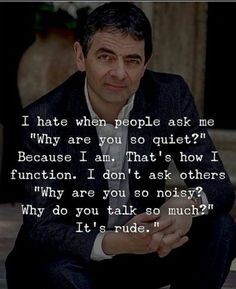
O solitude! If I must with thee dwell / Let it not be among the jumbled heap /..Sweet converse.. whose words are images of thoughts refin’d / is my soul’s pleasure
Keats was writing of his heartthrob and his love of pastoral nature but reflection, like writing, can best be seen as a solitary occupation.
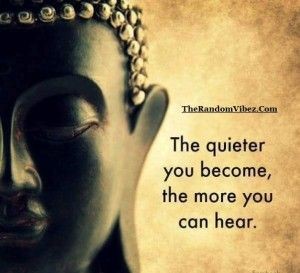
The idea that sitting still implies brooding should be resisted. There is no call to be thought in ‘a brown study’ or moody while reflecting. The ersatz sensation of doing something – being active is a norm for most of us – but simply sitting, as in a train and looking out of the window at passing scenery, can induce a meditative mood. The pa rt of one’s thinking process that is constantly ‘telling’ one to be active is stilled.
Benevolent feelings tend to uplift one to see broader vistas from a higher and more serene vantage point. The Rabbi, Naftali Lowenstein, asked by a tremulous pupil what last minute preparation to make on the day of an exam, advised the examinee to make a donation to charity. She said later that doing so helped put her in the right frame of mind for her task.
There are differences between the Western and Eastern approach, to speak in generality; and more than one recipe in each formulation.
One goal here is to import into your sessions of reflection in your own space your own equable perspective so that it permeates your waking actions and thoughts and enables you to deal better with exigencies that come up.

It is an idea to distinguish between weeds in the mind and the flowers; the shallow thoughts and transitory emotions that muddy the waters as opposed to the deeper, truer currents. See unwelcome thoughts for what they are: the enemy within. Give them no quarter. The old-school approach was to take a cold shower to banish unseemly thoughts. You can choose your own antidote, one that works for you. Below is just one suggested approach:
Reflecting can be like weeding. Self-destructive feelings or ideas that pursue you should be rooted out. Try exclaiming ‘WEED!’ if ambushed by them. This incidentally may be easier for septuagenarians who, as toddlers, saw the TV series: ‘Bill and Ben, the Flower Pot Men’ in which the name of ‘Little Weed’ always was spoken in a haunting cadence that tended to stick in the mind, as if to say ‘Better steer clear of this entity!’ It won’t work the first time. Negative thoughts will have already arisen before evasive action can be taken but the self-brainwashing that comes of reiteration of the same thoughts, good or bad, then linking them with conscious reproof where called for can become second nature if the will is there. If all else fails, jab a pin into your flesh by way of aversion therapy!
This exercise can help to reflect on ways of resetting one’s practical course in life the better to be able to deal with them. Self-destructive thought or emotion may continue to arise even after work has been done on alleviating them but can be drained of their capacity to induce, say, fear or anxiety. Arguably ‘bad’ things may happen for currently inscrutable purposes but even actors deliberately use first night nerves so as to give better performances.
Reflection requires equilibrium, one may have to work at attaining it.
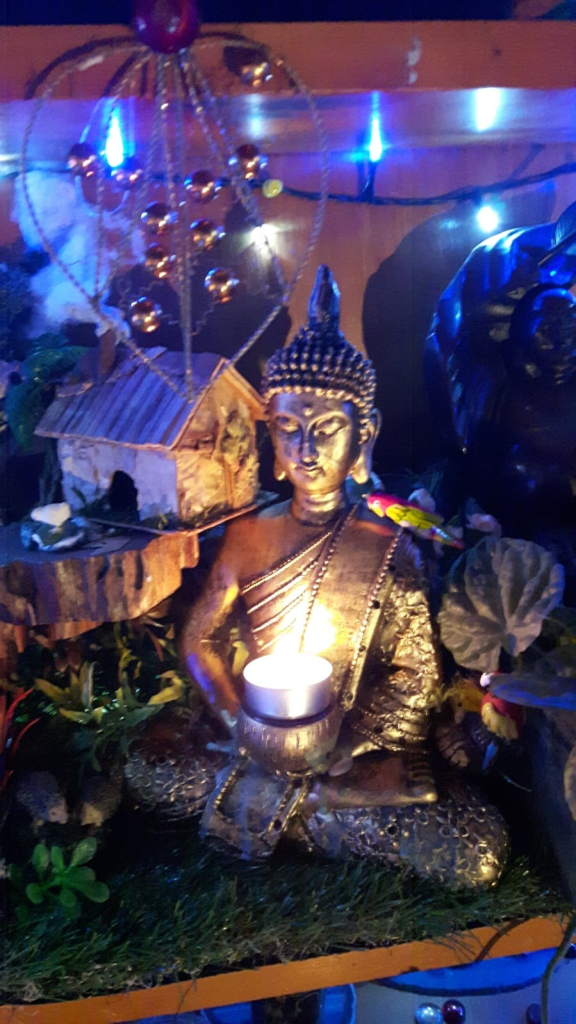
Much of the iconography typifying Meditation depicts Buddha. The calm and calming expresion of deep, benevolent thinking is writ large on images of Buddha. Much thinking deriving from the meditative practices in the East now is corroborated by scientific findings of the West. As but one of many examples, The Tibetan Book of the Dead describes experiences now demonstrable under laboratory conditions. It is no accident that the iconography of meditation often depicts Buddha. The posture and facial expression in images of Buddha has an appeal that transcends religious boundaries to those wishing to reflect.
Some meditative practices in India enjoin on devotees a communal session of laughing out loud before starting to meditate proper. Humour can lighten mood and enlighten as well as helping reach a balanced perspective. A light, amused perspective on the world, garnished with cerebral second thoughts, helps to banish dark thoughts and avoid for instance decisions taken in a fit of anger. A vein of humour can run through serious business. The jesters of Shakespeare’s plays and mediaeval courts were licensed to be fearless in speaking the truth. A sense of proportion, laced with common sense, can open a peephole into the core of things. Winston Churchill’s wit, for instance, formed part of his thinking about international affairs and frequently helped get across points such as: ‘If you go on with this nuclear arms race, all you are going to do is make the rubble bounce.’ Buddha was up for a good laugh if occasion offered despite his serious purpose as is celebrated in iconography by the ‘Laughing Buddha’.
An example of Holy Laughter can be found in Kenneth E. Hagin’s Drunk in the Spirit.

Some people may like the sketches of The Two Ronnies while others might prefer the subtleties in the humour of Victor Borge. You may like to scroll down to the Landing Box on humour. Some people however may feel that Meditation is no laughing matter…
This evidence of the role that can be played by humour is far from confined to esoteric practices. In Your Brain is Boss, Dr Lynda Shaw devotes a chapter to discussing the science behind why laughter is beneficial.
It is preferable not to follow a session of meditation with a busy schedule about which the mind may be turning. In some sects of Zen Buddhism watches are not to be worn. The striking of a gong and/or suitable rubric also helps create a sensation of time out of time.
When cogitating, insight is more liable to surface when in a calm and rational mood. Emotions and personal demons can be mastered – not necessarily entirely suppressed – so that they can be viewed in a detached way and seen as far as possible for what they are.
If the predominating note in the mind when wanting to reflect is of anger or fear one is liable to be more grounded in the things of this world, more the victim of emotion, less able to reach for the stars – more corralled into one line, one dimension. The last thing needed is to allow the worst thoughts full rein to prey on one’s mind…
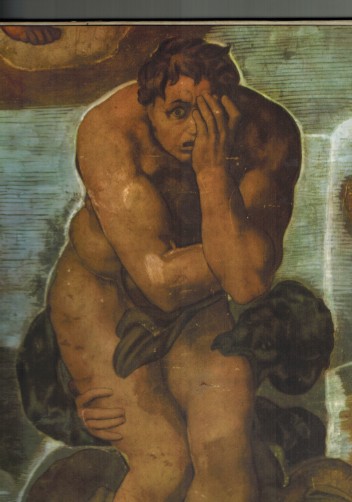
Detail of a painting by Michelangelo
The person wanting to de-stress or slumber restfully is spoiled for choice as to ways of bringing this off. The following link to a lecture by Roy Maunder will take the visitor to a calm place where he or she can de-stress and relax though it is not suggested that the visitor falls asleep which Mr Maunder’s suggestions and lullaby voice can induce.
‘To sleep, perchance to dream!’, as the Bard puts it. Technology can enhance the experience. A becalming, body-embracing bed, with temperature geared to body heat, has been invented by Anthony Fast. No need of owners of such a bed to visit a Massage Parlour; they can lie down in their own home, and reflect in utmost comfort. Details to be found here.
To quote Brian Mayne (see section relating to Barry Long in ‘Spiritual Matters’ under ‘Credos’ on this website),
‘If you reflect, each night you are successful in leaving the mind behind when you surrender to sleep. Meditation is not much different, except conscious awareness is maintained. We are actually still aware during sleep, but because there is no object to the awareness and we are not accustomed to just being aware of our own awareness without thoughts or objects, we do not notice it (are not conscious of it).’

Below are scenes from the two sanctuaries in the institute:



A sanctuary is any place you believe to be your sanctuary. Michael loves electronics and this is his sanctuary.

